Temples have always been a source of ancient history. Egypt is a reservoir of ancient temples, and they take us back through centuries of kings, queens, battles, glory and Egyptian gods. The building of temples dedicated to gods or sometimes themselves was an integral part of their reign and the nation.
The temples that were built then were made without any of the current technology or equipment. Nevertheless, the design and construction have always managed to fascinate and amaze today's society. Centuries have passed, and yet these monuments stand tall and proud, tested by the sands of time, reminding us of a glorious, long-gone time.
Karnak Temple
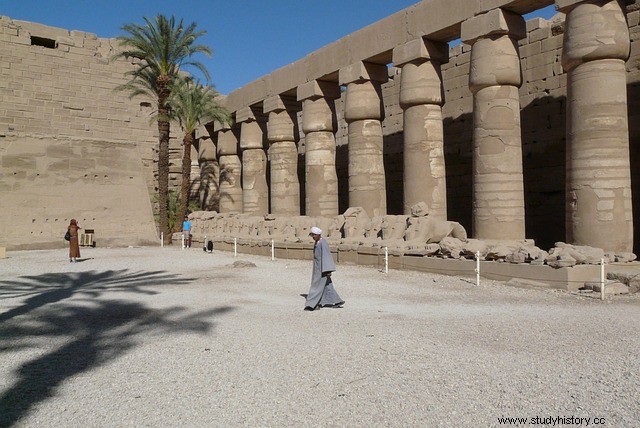
Karnak is the largest temple ever built and one of the most impressive structures in Egypt. The temple started as a single structure, but after various rulers passed by, several buildings were erected, renovated and expanded, leading to an entire village with old buildings.
Located on the banks of the Nile River in Thebes, Karnak was called the Amun Temple in antiquity. The Egyptians believed that Thebes was the first city to be created on a mound. According to them, Atum and Ptah, both creator gods, stood on the mound and began to create life. The place where the temple stands today was believed to be the original mound, and therefore the temple was built there. The temple was an observatory and a religious site where Amun, the Egyptian god of sun and air, wanted to interact with the earthly people, and therefore the temple was originally named after Amun. During the Arab invasion in 7 th century, the Arabs rediscovered the temple and called it 'Karanak', meaning 'fortified village', due to the amount of structures and architecture.
The original construction of the temple began in the Middle Kingdom (2040 - 1782 BCE) and continued throughout the New Kingdom (1570 - 1069 BCE) and the Ptolemaic dynasty (323 - 30 BCE). Due to the style of the ruins and the list of monarchs in the Old Kingdom inscribed in the banquet hall of Tuthmose III, some believe that construction began as early as the ancient kingdom. The names of the inscribed kings suggest that Tuthmose III may have removed some of the buildings of the ancient kings to build the great hall, but wished them to be immortalized in time.
Over the years, several temples were built, dedicated to various other deities, such as Osiris (the god of fertility, agriculture, life after death, the dead, the resurrection and life), Montu (the falcon god of war), Isis (divine mother of the pharaoh) , Ptah together with the kings who contributed to the construction of the temple. The temple of Amun is in the center. A small area dedicated to Amun's wife, the goddess Mut, stands to the south. To the north is another area dedicated to Montu. The eastern area of the site is dedicated to Athens, the solar disk. Other structures include Gateway of Pylons, Avenue of Sphinxes, Kiosk of Sesostris, Temple of Ptah, Hypostyle Hall, Sacred Lake and Temple of Osiris.
Abu Simbel Temples
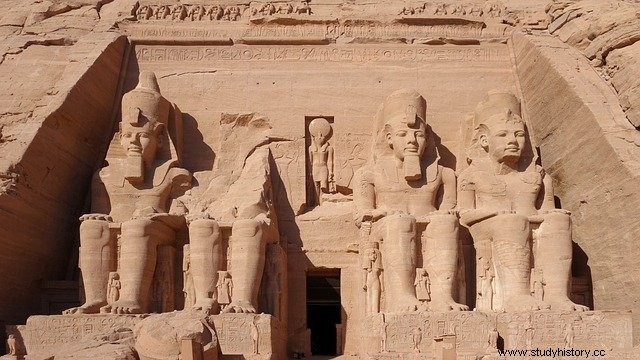
The Abu Simbel temples are located in the village of Abu Simbel, on the lower cataract of the Nile in southern Egypt. The temples are stone-cut temples, carved into a rock during the reign of Pharaoh Ramesses II (ca. 1279 - ca. 1213 BCE).
Construction of the temple began around 1264 BC. and continued for twenty years, until 1244 BC. The temple complex has two temples - the large, dominant temple of Ramesses II and a smaller temple dedicated to his main wife, Nefertari and the goddess Hathor. Ramesses II built the temples to celebrate his victory over the Hittites (an ancient group of Indo-Europeans who migrated into the Asian Minor, leading to the formation of an empire at Hattusa in Anatolia) at the Battle of Kadesh.
The temple of Ramesses is known as the great temple, and it is dedicated to the Egyptian gods Amun, Ra-Horakhty (the god of the rising sun) and Ptah, along with Ramesses himself. Standing 33 meters high and 30 meters wide, the entrance has four giant statues of Ramesses sitting on his throne. Two on each side of the entrance are each of the colossal statues 20 meters high. There are several smaller statues next to Ramesses' legs, depicting his main wife, Nefertari, his queen mother Mut-Tuy, his first two sons and his first six daughters. A facade behind the colossi supports a frieze that has the image of twenty-two baboons with raised arms worshiping the rising sun. Ramesse's marriage to the daughter of King Hattuslli III is recorded on a stone slab. Ra-Horakhty's statue stands in a niche, with pictures of Ramesses worshiping him. Maat, the goddess of truth and justice, stands to the left of Ra.
The small temples of Hathor and Nefertari are 12 meters high and 28 meters wide. Like the great temple, the entrance is flanked by six colossi (three on each side) - four figures of the Ramesses and two of the Nefertari. The statues are the same size here. As in the Great Temple, several statues of their children are also erected. The walls of the temple show pictures of the king and queen worshiping the gods and pictures of the goddess Hathor.
The temples were moved between 1964 and 1968 to save them from being sunk during the construction of the Aswan High Dam. The relocation - cutting the stones into large blocks, dismantling, lifting and reassembling - was necessary to save the temples from flooding. The new location was several hundred meters higher from the river bank.
Luxor Temple
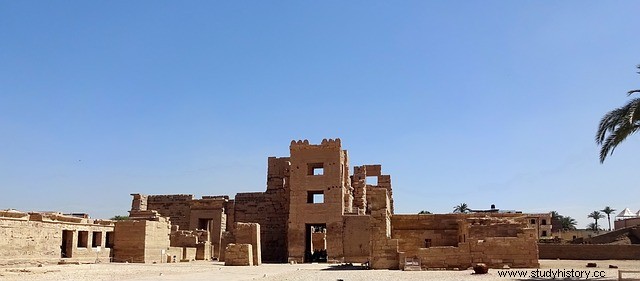
The Luxor Temple is located on the east bank of the Nile, in Luxor (originally called Thebes). The temple was built around 1400 BC, and is surrounded by several other impressive structures, making it a temple complex. Like Karnak, many rulers made their own contributions and eventually led the site to a temple complex.
According to many studies, the Luxor Temple was dedicated to the Theban triad of gods - Amun, his wife Mut and their son Khonsu. However, according to new studies, unlike other temples in Egypt, the Luxor Temple was not dedicated to any god or pharaoh. Instead, it is believed to be dedicated to the rejuvenation of the kingdom. Many of the Egyptian pharaohs were crowned at this place.
The chapel at the back of the temple was built by Amenhotep III (1390-52 BC). Other contributions were made by Tutankhamun (1336-27 BC), Horemheb (1323-1295 BC) and Ramses II. The granite shrine at the back of the temple was dedicated to Alexander the Great. The entrance is flanked by two obelisks with different heights, but gives the illusion that they were of the same height. An avenue of sphinxes with the human head connects the temple with Karnak. The Abu Haggag Mosque is located inside the temple. It was converted into a chapel by the Romans in 395 AD, then into a mosque in 640. Therefore, the place has been in religious worship for more than 3400 years.
Temple of Hatshepsut
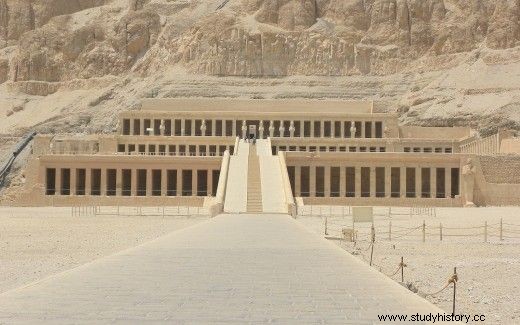
The Hatshepsut Temple is a mortuary temple located in Upper Egypt on the west bank of the Nile. The temple is dedicated to Amun and Hatshepsut, the queen of the eighteenth dynasty who died in 1458 BC. The temple is located under the cliff in Deir el-Bahari.
Queen Hatshepsut was a great admirer of the mortuary of Mentuhotep II (ca. 2061-2010 BC). Mentuhotep was a Theban prince who founded the eleventh dynasty. Although his mortuary was an impressive structure, he was not actually buried inside it. His final resting place is a tomb cut inside the rocks behind the temple. Hatshepsut wanted her temple to reflect the design of Mentuhoteps, but at the same time have significant differences as well - it had to be bigger and bigger. She ordered her temple to be built next to Mentuhoteps. As a woman in a traditionally male-dominated position, she wanted to ensure that her reign would be remembered and not overshadowed by any pharaoh of the past or future. Her government was not only prosperous, but also one of the most peaceful governments in Egypt. She led early military expeditions and kept her arm on top. Trade and the economy flourished, and many beautiful monuments were commissioned by her.
And the temple really documented her magnificent reign. Towering obelisks flank the main entrance. There are three levels in the temple. The courtyard on the first level leads to archways on both sides. To reach the second level you had to pass through a long, elaborate ramp after the first level. The entrance to the second level has two statues of lions. Inside the second level are two reflective pools. Sphinxes are on their way to another ramp that will take you to the third level. All levels have elaborate paintings, reliefs and pictures on the walls. These are lush inner gardens. The temple also has a hypostyle (a hall with pillars supported by a pillar), a solarium, courts, a shrine and a chapel.
Seti I Temple
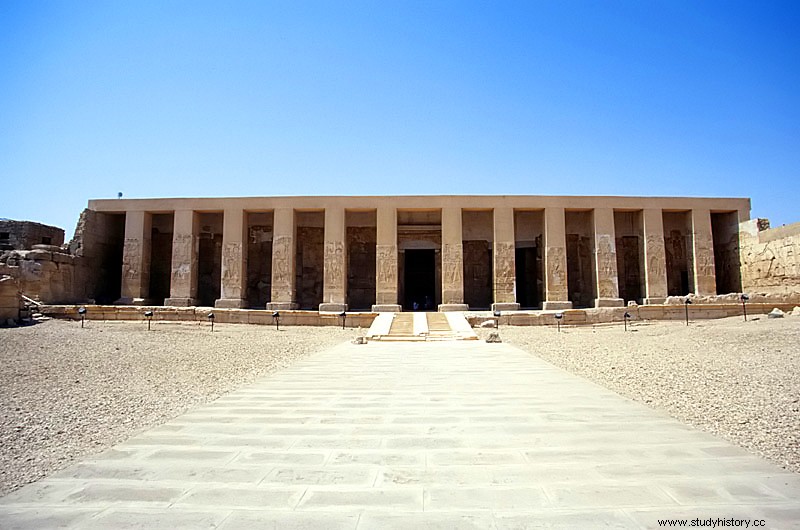
Located in Theban Necropolis in Upper Egypt is the morgue Temple of Seti I. It was built in memory of Seti I (1290-1279 BC), the pharaoh of the new kingdom. The temple is located in the city of Abydos, a site of many other ancient temples. The first kings of Egypt were buried here, and therefore Abydos was considered one of the holiest lands in Egypt. Under his rule, Seti rebuilt damaged temples, opened mines, and made his own contribution to the Karnak Temple.
Unlike the other temples which had a rectangular shape, the Seti temple has an L-shape. Construction began under Seti's rule, but was completed after his death by his son Ramesses II. Limestone was primarily used with the occasional sandstone in some areas. A pylon leads to the main entrance, which opens into the first space. A staircase climbs onto a raised terrace complete with a hall. The hall leads to the second path through three different entrances. Ramesses decorated the courtyards with depictions of the battle of Kadesh and the king who worshiped the gods. Another pillar hall shows pictures of Seti I kneeling before the gods. Outside the second hall are seven chapels dedicated to seven gods:the divine form of Seti I, Osiris, Isis, Amun, Ra-Horakhty, Ptah and Horus. There is also a shrine dedicated to Seti's father, Ramesses I, whose reign lasted less than two years. Most of the courtyard and pylons are in ruins now, but the temple still retains some of its glory.
